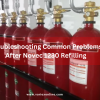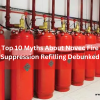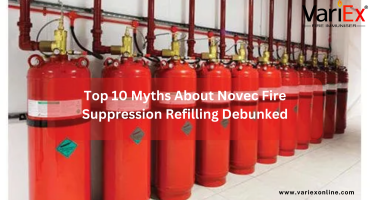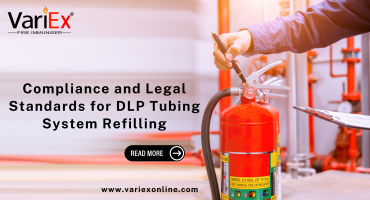![]()
Fire Immuniser
+91-7829629111
Email: info@variex.in
Varistor Technologies Pvt. Ltd.
Block-1, First Floor, Ardente Office One, Hoodi Circle, ITPL Main Road, Bengaluru, Karnataka 560048, IN
Fire Safety Equipment Role in Preventing Workplace Accidents
Fire Safety Equipment Role in Preventing Workplace Accidents
Fire safety is a crucial aspect of workplace safety management. Businesses, whether large or small, need to be well-prepared to handle potential fire hazards to protect their employees, property, and assets. The consequences of fire accidents can be devastating, leading to injuries, fatalities, and significant financial losses. This is where the importance of fire safety equipment comes in. Having the right fire safety tools and implementing fire prevention strategies can reduce the risk of accidents, ensuring a safer environment for everyone.
In this blog, we will discuss how different types of fire safety equipment play a pivotal role in preventing workplace accidents, provide guidelines on selecting the right equipment, and highlight best practices for their maintenance and usage.
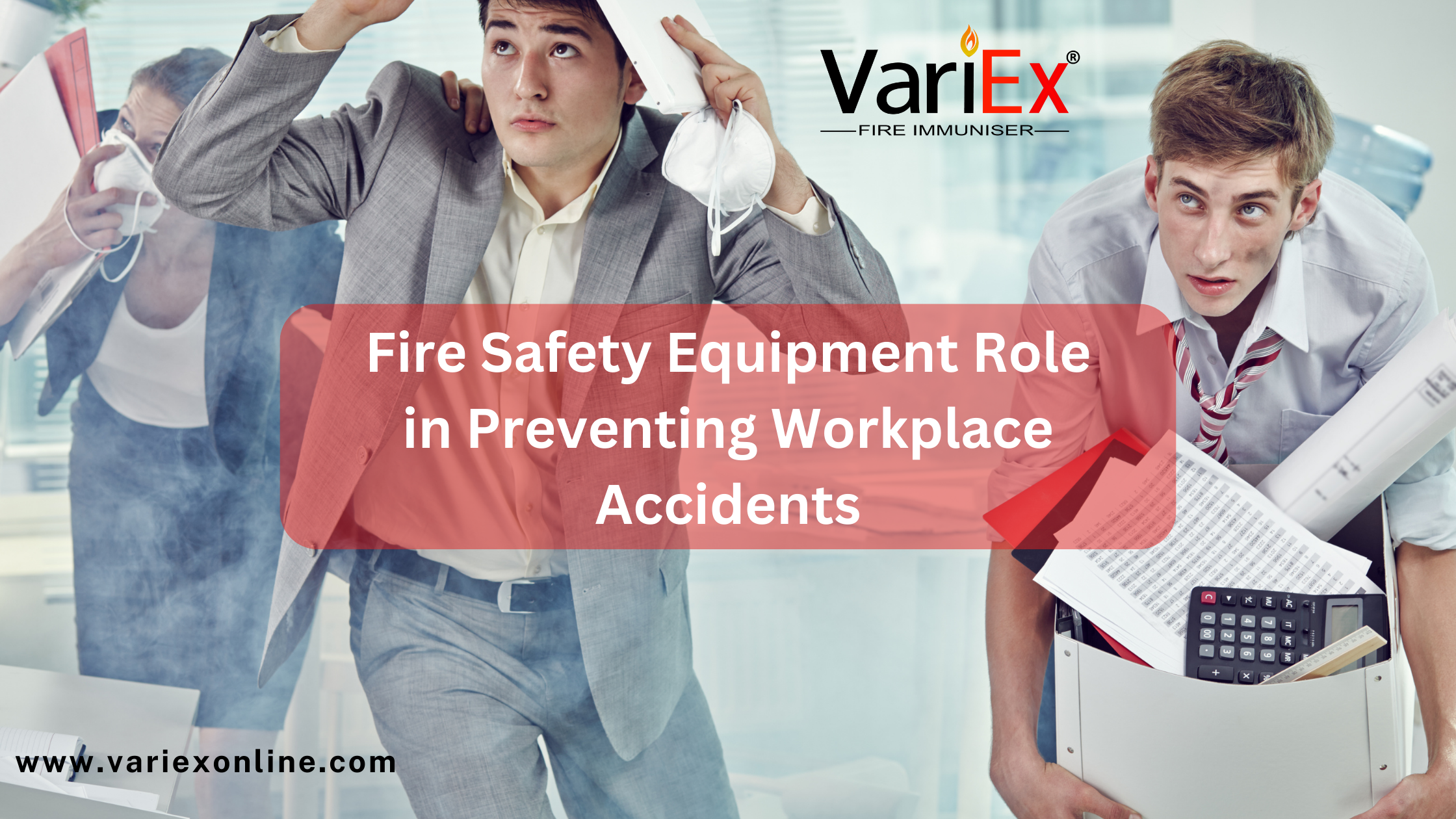
Understanding Fire Hazards in the Workplace
Workplace fires can occur due to a variety of reasons, including electrical malfunctions, flammable chemicals, improper storage of combustible materials, and human error. Understanding the common fire hazards present in a particular workspace is the first step in determining the type of safety equipment needed. According to the National Fire Protection Association (NFPA), the most frequent causes of workplace fires include:
- Electrical malfunctions: Frayed wires, overloaded circuits, and faulty equipment.
- Heating equipment: Poorly maintained heaters or malfunctioning furnaces.
- Flammable materials: Improper storage of chemicals, gas cylinders, and other flammables.
- Human error: Smoking, improper handling of equipment, or lack of awareness.
Each workplace will have its own unique set of fire risks, depending on the nature of the business, materials used, and equipment operated. It is essential to conduct a thorough risk assessment to identify potential fire hazards and plan accordingly.
Essential Fire Safety Equipment for Preventing Workplace Accidents
There are several types of fire safety equipment designed to address different types of fires and emergencies. The right combination of fire safety tools can minimize damage and prevent fires from escalating into major accidents. Below, we highlight some of the most critical fire safety equipment and their roles:
1. Fire Extinguishers
Fire extinguishers are the most commonly used fire safety devices in workplaces. They are portable devices used to suppress small fires before they grow out of control. There are different classes of fire extinguishers, each designed to handle specific types of fire:
- Class A: For ordinary combustibles like wood, paper, and cloth.
- Class B: For flammable liquids such as gasoline, oil, and paints.
- Class C: For electrical fires caused by live electrical equipment.
- Class D: For fires involving combustible metals like magnesium and aluminum.
- Class K: For kitchen fires, especially those involving cooking oils and fats.
Proper training on the use of fire extinguishers is crucial to ensure employees can operate them effectively in an emergency.
| Class | Type of Fire | Suitable For | Example of Usage |
|---|---|---|---|
| A | Ordinary combustibles | Wood, paper, textiles | Offices, Warehouses |
| B | Flammable liquids | Gasoline, oil, solvents | Chemical Laboratories, Fuel Stations |
| C | Electrical fires | Live electrical equipment, wiring | IT Departments, Electrical Workshops |
| D | Combustible metals | Magnesium, titanium, aluminum | Metal Workshops, Manufacturing Units |
| K | Cooking oils and fats | Cooking oil, grease | Commercial Kitchens, Restaurants |
2. Fire Blankets
Fire blankets are safety devices made of fire-resistant materials, designed to smother small fires. They are especially useful for extinguishing flames on a person’s clothing or handling small kitchen fires. Fire blankets can also be used to wrap around a person to protect them while escaping through a fire-affected area.
3. Smoke and Heat Detectors
Smoke and heat detectors are essential for early fire detection. These devices alert occupants of a potential fire by sensing smoke or unusual increases in temperature. Early warning allows for quick evacuation and prevents the fire from spreading uncontrollably. There are several types of detectors:
- Ionization smoke detectors: Best for detecting fast-flaming fires.
- Photoelectric smoke detectors: Ideal for sensing smoldering fires.
- Heat detectors: Trigger alarms based on a sudden rise in temperature.
4. Sprinkler Systems
Sprinkler systems are designed to activate automatically when a fire is detected, spraying water to suppress flames. This system is highly effective in preventing fires from spreading and causing extensive damage. Different types of sprinklers (wet, dry, pre-action, and deluge) cater to various fire suppression needs based on the environment.
5. Fire Alarms and Emergency Lighting
Fire alarms serve as an immediate alert system, informing occupants of a fire emergency. Emergency lighting, on the other hand, helps guide employees to exits during an evacuation. Both are critical components of a comprehensive fire safety strategy and must be installed in strategic locations across the workplace.
6. Fire Doors and Exit Signage
Fire doors are designed to contain fires and prevent them from spreading to different parts of the building. Proper exit signage indicates safe evacuation routes, helping employees find their way out quickly during an emergency.
Benefits of Fire Safety Equipment in the Workplace
Implementing the right fire safety equipment not only reduces the risk of accidents but also brings a range of benefits to businesses, such as:
- Employee Safety: Protecting employees from harm is a top priority. Fire safety equipment helps ensure a safe work environment and reduces the risk of injuries.
- Asset Protection: Preventing fires minimizes the potential damage to equipment, machinery, and inventory, saving the business from financial losses.
- Compliance: Meeting fire safety standards is essential for regulatory compliance. Proper fire safety equipment ensures adherence to local and national fire safety codes.
- Reduced Insurance Premiums: Businesses equipped with effective fire safety measures may benefit from lower insurance premiums as they are perceived as lower risk.
Implementing a Fire Safety Plan
A comprehensive fire safety plan is essential to ensure that all safety equipment is used effectively and that employees know how to respond during an emergency. Below are some key components of a robust fire safety plan:
1. Conduct Regular Risk Assessments
Identify potential fire hazards in the workplace and determine the types of fire safety equipment needed. Risk assessments should be updated periodically, especially when there are changes in operations or the introduction of new equipment.
2. Install the Right Fire Safety Equipment
Based on the risk assessment, ensure that the appropriate types of fire safety equipment are installed and easily accessible. This includes fire extinguishers, detectors, and emergency lighting.
3. Employee Training and Drills
Training employees on the proper use of fire safety equipment is crucial. Regular fire drills should be conducted to reinforce evacuation procedures and ensure that everyone knows their role in an emergency.
4. Maintenance and Inspections
Fire safety equipment must be inspected and maintained regularly to ensure that it remains in working condition. Create a maintenance schedule to check devices like extinguishers, smoke detectors, and sprinklers periodically.
5. Establish Clear Communication Channels
During a fire emergency, clear communication is vital. Designate safety personnel who are responsible for alerting authorities, guiding employees, and coordinating evacuation efforts.
Best Practices for Using Fire Safety Equipment
To ensure the effectiveness of fire safety equipment in preventing workplace accidents, follow these best practices:
- Place Equipment in Visible and Accessible Areas
Fire extinguishers, fire blankets, and alarms should be installed in easily accessible locations, free of any obstructions. - Use the Right Type of Fire Extinguisher
Match the fire extinguisher to the specific fire hazard. Using the wrong type can worsen the situation, especially with electrical or chemical fires. - Provide Regular Employee Training
Employees should know how to operate fire extinguishers and other safety devices, and they should be familiar with emergency evacuation routes. - Inspect and Test Equipment Regularly
Schedule routine inspections and testing of fire safety devices to identify any malfunctions or expired components. - Create a Fire Safety Committee
Appoint a team of employees to oversee fire safety initiatives, conduct safety drills, and ensure compliance with safety regulations.
Conclusion
Fire safety equipment is an essential investment for every workplace. It not only safeguards the well-being of employees but also helps protect assets, ensures compliance, and prevents costly disruptions. By understanding the role of various fire safety tools and implementing a robust fire safety plan, businesses can significantly reduce the risk of workplace accidents and create a safer working environment.
Regular training, risk assessments, and maintenance are key to ensuring that fire safety equipment performs optimally when it is needed the most. By taking proactive measures, companies can effectively mitigate fire hazards and safeguard their workforce and operations.
Frequently Asked Questions
Fire safety equipment is essential because it helps detect, control, and suppress fires early, reducing the risk of injuries, property damage, and business disruptions.
Every workplace should have fire extinguishers, smoke detectors, sprinkler systems, fire alarms, emergency lighting, and clearly marked exit signs to ensure comprehensive fire protection.
Choose based on fire hazards present: use Class A for ordinary combustibles, Class B for flammable liquids, Class C for electrical fires, and Class K for kitchen-related fires.
Fire safety equipment should be inspected monthly and professionally checked annually to ensure it remains in proper working condition.
Employee training enhances preparedness, ensures correct use of fire safety equipment, and promotes safe evacuation, minimizing risks during emergencies.
Final Say
At VariEx.in and VariexOnline.com, we specialize in supplying and installing top-quality fire fighting systems and equipment. From fire extinguishers to advanced suppression systems, we offer comprehensive solutions tailored to your needs. Our experienced team ensures precise installation and maintenance for optimal safety.
Trust VariEx for reliable fire protection. Contact us online or call 7829629111 to learn more.
We specialize in manufacturing, supplying, and distributing a comprehensive range of fire fighting equipment, including state-of-the-art fire extinguishers. Read our most searched blogs and find interesting information on topics such as how to use a fire extinguisher, how to calculate fire fighting water tank capacity, fire extinguisher refilling, obtaining a Fire NOC, understanding fire fighting systems, types of fire protection systems, the fire hydrant system, and the fire sprinkler system. These resources provide essential knowledge for ensuring safety and compliance with fire safety regulations. Additionally, you can explore guides on the maintenance of fire protection equipment, the latest advancements in fire safety technology, and best practices for fire risk assessment and management.
Our expertise extends to fire alarm systems, fire hydrant systems, and fire suppression systems, including fire sprinklers. Each product meets rigorous international standards for reliability and performance, ensuring effective fire safety products tailored to diverse applications and industries. Additionally, we are providing Fire Extinguisher Refilling and AMC services to ensure ongoing maintenance and operational readiness of fire safety equipment.
"WHAT YOU CAN READ NEXT"
 Read more +24 November 2023 in Fire Extinguisher
Read more +24 November 2023 in Fire ExtinguisherWhat types of fire extinguishers are available for different fire classes?
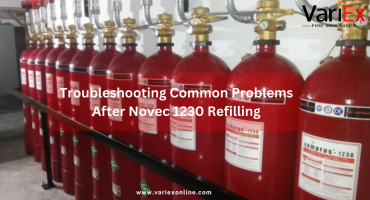 Read more +18 April 2025 in Fire Suppression
Read more +18 April 2025 in Fire Suppression

